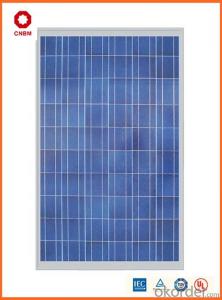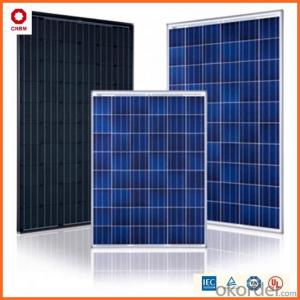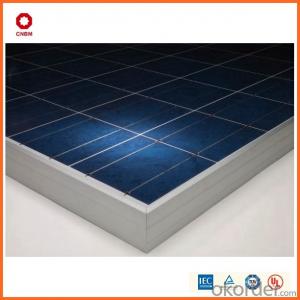25w Small Solar Panels in Stock China Manufacturer
- Loading Port:
- China main port
- Payment Terms:
- TT OR LC
- Min Order Qty:
- 10 watt
- Supply Capability:
- 10000000 watt/month
OKorder Service Pledge
OKorder Financial Service
You Might Also Like
Item specifice
Product Description:
Hot Sale !!! Quality and Safety of Small Poly Solar Panel 5w~150w
1. Rigorous quality control meets the highest international standards.
2. High-transmissivity low-iron tempered glass, strong aluminium frame.
3. Using UV-resistant silicon.
4. IS09001/14001/CE/TUV/UL
Warranties of Small Poly Solar Panel 35~85w
1. 10 years limited product warranty
2. 15 years at 90% of the minimal rated power output
3. 25 years at 80% of the minimal rated power output
Specification
Characteristics of Poly solar panels CNBM (245-320W) | |||||
Max Power Voltage Vmp(V) | 30.3 | 30.8 | 31.1 | 31.4 | 31.85 |
Max Power Current Imp(A) | 7.60 | 7.64 | 7.73 | 7.81 | 7.85 |
Open Circuit Voltage Voc(V) | 36.1 | 36.6 | 37 | 37.3 | 37.68 |
Short Circuit Current Isc(A) | 8.50 | 8.55 | 8.65 | 8.75 | 8.85 |
Max Power Pm(W) | 230W | 235W | 240W | 245W | 250W |
Temperature Coefficient of Cells Poly solar panels CNBM (245-320W) | |
NOCT | 45± 2 |
Temperature Coeffucients of Isc | 0.0492 |
Temperature Coeffucients of Voc | -0.3374 |
Temperature Coeffucients of Voc | -0.4677 |
Mechanical Data of Poly solar panels CNBM (245-320W) | |
Dimension | 1638 × 982 × 40 mm |
Weight | 19.5 kg |
No. of Cells and Connections | 60 (6 ×10) |
Tolerance | 0 ~ + 5 W |
Cell | Monocrystalline Cell 156 × 156 mm |
Packing | 624 Pcs/40ft(H) Container |
Limits of Poly solar panels CNBM (245-320W) | |
Operating Temperature | -40 to +85 |
Storage Temperature | -40 to +85 |
Max System Voltage | 1000VDC(IEC) / 600VDC(UL) |
Features of our products:
• High conversion efficiency mono/poly-crystalline amorphous silicon solar cells
• Modules incorporate high performance bypass diodes to minimize the power drop caused by shading
• High transmittance, low-iron tempered glass
• High performance EVA encapsulant to prevent destroying and water.
• AI frame: without screw, corner connection. 8 holes on the frame can be installed easily
• Good performance of preventing from atrocious weather such as wind and hails
• Certifications: CE IEC TUV VDE UL, Class I
• 10 years 90% power output warranty

Shipping of Small Poly Solar Panel 35~85w
By Sea | Delivery from Shanghai or Ningbo seaport |
By Air | Departure from Shanghai Pudong Airport |
By Express | Post by DHL, EMS, UPS, TNT. |
Features of our products:
• High conversion efficiency mono/poly-crystalline amorphous silicon solar cells
• Modules incorporate high performance bypass diodes to minimize the power drop caused by shading
• High transmittance, low-iron tempered glass
• High performance EVA encapsulant to prevent destroying and water.
• AI frame: without screw, corner connection. 8 holes on the frame can be installed easily
• Good performance of preventing from atrocious weather such as wind and hails
• Certifications: CE IEC TUV VDE UL, Class I
• 10 years 90% power output warranty
As a professional Solar Panel manufacturer and Supplier in China, we have our customers come around the whole world and our specialization has got a worldwide recognition. Meanwhile, with our superior quality, competitive price, prompt and excellent service, As main role in trade section of CNBM Group, CNBM International Corporation supplies products including Monocrystalline Solar Panel, Polycrystalline Solar Panel ( multicrystalline silicon Solar Panel) have received and enjoyed famous reputation in many countries and regions in the world.
- Q:Are there any limitations to the amount of electricity a solar energy system can generate?
- Yes, there are limitations to the amount of electricity a solar energy system can generate. These limitations include factors such as the size and efficiency of the system, the amount of sunlight available, and the geographical location of the system. Additionally, external factors like weather conditions and shading can affect the system's performance and limit its electricity generation.
- Q:Can solar energy systems be used in indoor farming or greenhouse applications?
- Yes, solar energy systems can be used in indoor farming or greenhouse applications. Solar panels can be installed on the rooftops of greenhouses or indoor farming facilities to generate electricity, which can then be used to power various operations such as lighting, ventilation, and irrigation systems. This sustainable approach can help reduce energy costs and greenhouse gas emissions while providing a clean and renewable source of power for indoor farming.
- Q:How do solar energy systems impact public health?
- Solar energy systems have a positive impact on public health. They reduce air pollution associated with fossil fuel combustion, leading to improved air quality and decreased respiratory diseases. Additionally, solar energy systems do not produce hazardous waste or emissions, reducing the risk of water and soil contamination. Overall, the adoption of solar energy systems promotes a healthier environment and enhances public health outcomes.
- Q:Are there any limitations to using solar energy systems?
- Yes, there are a few limitations to using solar energy systems. Firstly, solar panels require sunlight to generate electricity, so their efficiency is dependent on weather conditions and geographical location. Cloudy or shaded areas may significantly reduce their output. Additionally, solar energy is intermittent and cannot be generated at night, requiring the use of batteries or grid connections for continuous power supply. Moreover, the initial installation cost of solar systems can be high, although it is generally offset by long-term savings. Finally, large-scale implementation of solar energy may require substantial land area, potentially impacting ecosystems and land use. However, advancements in technology and increasing affordability are continuously reducing these limitations.
- Q:Are there any risks of electromagnetic interference with solar energy systems?
- Solar energy systems can be affected by electromagnetic interference (EMI), which refers to the disruption caused by electromagnetic radiation. This interference can impact the functioning of electronic devices. EMI can arise from various external sources and pose potential risks to solar energy systems. One common source of EMI is radio frequency interference (RFI) generated by nearby radio or television transmitters, radar systems, or wireless communication devices. These devices emit electromagnetic waves that can interfere with the operation of solar energy systems. This interference can lead to reduced power output, decreased efficiency, or even complete system failure. Another possible source of EMI is power line interference. Solar energy systems are typically connected to the electrical grid, and fluctuations or disturbances in the grid's electrical signals can introduce interference into the system. This can be caused by nearby power lines, electrical substations, or other electrical equipment. To mitigate the risks of EMI, solar energy systems are designed and installed with measures to minimize interference. These measures include using shielded cables, employing grounding techniques, and ensuring adequate spacing between components to reduce the impact of external electromagnetic fields. Additionally, solar inverters, which convert the DC power generated by solar panels into AC power, are often equipped with EMI filters to prevent interference from affecting the system's operation. It is crucial for solar energy system installers and manufacturers to adhere to relevant safety standards and regulations to ensure that the systems are resistant to EMI. Regular maintenance and inspections can also aid in identifying and addressing any potential EMI issues. In conclusion, although the risks of EMI exist for solar energy systems, proper design, installation, and maintenance practices can significantly minimize the impact and ensure the reliable and efficient operation of these systems.
- Q:Can solar panels be installed on canopies or awnings?
- Yes, solar panels can be installed on canopies or awnings. This allows for the utilization of space that would otherwise not be used for solar energy generation. Additionally, it provides shade while generating clean and renewable electricity.
- Q:How do solar energy systems impact the reliability of electricity supply during blackouts?
- Solar energy systems can have a positive impact on the reliability of electricity supply during blackouts. With a properly installed solar energy system, homeowners and businesses can have access to electricity even when the grid goes down. This is because solar panels generate electricity from sunlight, which means they are not reliant on the traditional power grid. During the day, when the sun is shining, solar panels can produce electricity and power the electrical needs of a home or business. Any excess energy generated by the solar panels can be stored in batteries for later use. This stored energy can be utilized during the night or during power outages, providing a reliable source of electricity when the grid is down. Additionally, solar energy systems can be equipped with an inverter and a smart system that allows them to disconnect from the grid in the event of a blackout. This is known as islanding, where the solar panels continue to generate electricity for local consumption while isolating themselves from the main power grid. This feature ensures that solar-powered homes and businesses can continue to operate even when the grid is down. The reliability of solar energy systems during blackouts depends on the size and capacity of the system and the amount of energy stored in the batteries. Larger solar systems with ample battery storage can provide extended periods of electricity supply during blackouts, whereas smaller systems may only provide power for a limited time. It is important to note that the reliability of solar energy systems during blackouts also depends on maintenance and regular inspections. Ensuring that the solar panels, batteries, and other components are functioning properly will maximize their performance during power outages. Overall, solar energy systems can greatly enhance the reliability of electricity supply during blackouts. They provide a sustainable and independent source of electricity, reducing dependence on the grid and increasing resilience in the face of power disruptions.
- Q:Can solar energy systems be used in cold climates?
- Yes, solar energy systems can be used in cold climates. While colder temperatures can slightly reduce the efficiency of solar panels, advancements in technology have made it possible to generate electricity from sunlight even in freezing conditions. Additionally, snow can be easily cleared from solar panels to ensure their optimal performance. With proper design and insulation, solar energy systems can effectively harness the sun's energy in cold climates and provide a sustainable source of power.
- Q:How do solar energy systems impact the electric grid?
- Solar energy systems have a significant impact on the electric grid by reducing the demand for electricity from traditional sources. As more solar power is generated and fed into the grid, it helps to stabilize the grid by diversifying the energy mix. Additionally, solar systems can reduce peak demand during daylight hours, leading to cost savings and less strain on the grid infrastructure. However, the intermittent nature of solar power can pose challenges in grid management, requiring grid operators to carefully balance supply and demand to ensure grid reliability.
- Q:Can solar energy systems be used in areas with limited construction materials?
- Yes, solar energy systems can be used in areas with limited construction materials. Solar panels can be installed on rooftops or mounted on frames, requiring minimal construction materials. Additionally, small-scale solar systems such as solar lanterns or portable solar chargers can be used in areas with limited construction materials. These systems provide a sustainable and reliable source of energy, even in remote or resource-constrained locations.
1. Manufacturer Overview |
|
|---|---|
| Location | |
| Year Established | |
| Annual Output Value | |
| Main Markets | |
| Company Certifications | |
2. Manufacturer Certificates |
|
|---|---|
| a) Certification Name | |
| Range | |
| Reference | |
| Validity Period | |
3. Manufacturer Capability |
|
|---|---|
| a)Trade Capacity | |
| Nearest Port | |
| Export Percentage | |
| No.of Employees in Trade Department | |
| Language Spoken: | |
| b)Factory Information | |
| Factory Size: | |
| No. of Production Lines | |
| Contract Manufacturing | |
| Product Price Range | |
Send your message to us
25w Small Solar Panels in Stock China Manufacturer
- Loading Port:
- China main port
- Payment Terms:
- TT OR LC
- Min Order Qty:
- 10 watt
- Supply Capability:
- 10000000 watt/month
OKorder Service Pledge
OKorder Financial Service
Similar products
New products
Hot products
Hot Searches
Related keywords






























